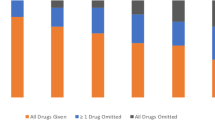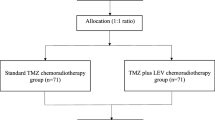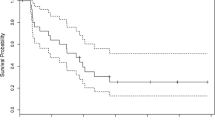Abstract
The purpose of this study was to evaluate safety and efficacy of Procarbazine (PCB) and fotemustine (FTM) combination in the treatment of pre-temozolomide treated, recurrent GBM patients. The primary end-point was progression free survival at 6 months (PFS-6). Secondary end-points were overall survival, response rates (CR + PR) and toxicity. About 54 patients (41 men and 13 women) aged 26–68 years (median age, 53.5 years) with recurrent GBM were treated. PCB was administered as an oral dosage of 450 mg on days 1–2 and a total dose of 300 mg on day 3. FTM was administered on day 3, 3 h after the last PCB intake at a dose of 110 mg/mq/BSA. The treatment was repeated every 5 weeks. Treatment was continued for a maximum of six cycles or until disease progression. After two cycles of chemotherapy: 6 patients (11.2%) experienced a neuroradiographic partial response (PR), 29 patients (53.7%) had stable disease (SD), and 19 patients (35.1%) had progressive disease (PD). For the whole group of patients, the median PFS was 19.3 weeks (95% CI, 14.1–24.4 weeks), and PFS-6 was 26.7% (95% CI, 10.6–42.8%). Overall MST from the beginning of PCB + FTM chemotherapy was 28.7 weeks (95% CI, 24.8–32.7 weeks). At 6 and 12 months, 64.4% (95% CI, 51.5–77.3%) and 23.6% (95% CI, 10.1–37.1%) of patients were alive. The median survival time calculated from the first diagnosis was 20.8 months (95% CI, 16.7–24.8). We concluded that the PCB + FTM combination as done in the current trial for patients with recurrent GBM after treatment with TMZ showed some benefit with regards to increased survival and that a Phase III trial is warranted.

Similar content being viewed by others
References
Brada M, Hoang-Xuan K, Rampling R, Dietrich PY, Dirix LY, Macdonald D, Heimans JJ, Zonnenberg BA, Bravo-Marques JM, Henriksson R, Stupp R, Yue N, Bruner J, Dugan M, Rao S, Zaknoen S (2001) Multicenter phase II trial of temozolomide in patients with glioblastoma multiforme at first relapse. Ann Oncol 7:259–266
Simpson L, Galanis E (2006) Recurrent glioblastoma multiforme: advances in treatment and promising drug candidates. Expert Rev Anticancer Ther 6:1593–1607
Hau P, Baumgart U, Pfeifer K, Bock A, Jauch T, Dietrich J, Fabel K, Grauer O, Wismeth C, Klinkhammer-Schalke M, Allgauer M, Schuierer G, Koch H, Schlaier J, Ulrich W, Brawanski A, Bogdahn U, Steinbrecher A (2003) Salvage therapy in patients with glioblastoma: is there any benefit. Cancer 98:2678–2686
Vordermark D, Kolbl O, Ruprecht K, Vince GH, Bratengeier K, Flentje M (2005) Hypofractionated stereotactic re-irradiation: treatment option in recurrent malignant glioma. BMC Cancer 5:55
Grosu AL, Weber WA, Franz M, Stark S, Piert M, Thamm R, Gumprecht H, Schwaiger M, Molls M, Nieder C (2005) Reirradiation of recurrent high-grade gliomas using amino acid PET (SPECT)/CT/MRI image fusion to determine gross tumor volume for stereotacticfractionated radiotherapy. Int J Radiat Oncol Biol Phys 63:511–519
Stupp R, Mason WP, van den Bent MJ et al (2005) Radiotherapy plus concomitant and adjuvant temozolomide for glioblastoma. N Engl J Med 352:987–996
Yung WK, Albright RE, Olson J et al (2000) A phase II study of temozolomide vs. procarbazine in patients with glioblastoma multiforme at first relapse. Br J Cancer 83:588–593
Stupp R, Hegi ME, van den Bent MJ et al (2006) Changing paradigms—an update on the multidisciplinary management of malignant glioma. Oncologist 11:165–180
Macdonald DR, Cascino TL, Schold SC Jr et al (1990) Response criteria for phase II studies of supratentorial malignant glioma. J Clin Oncol 8:1277–1280
Common Terminology Criteria for Adverse Events v3.0 (CTCAE) (2003) Cancer Therapy Evaluation Program, Common Terminology Criteria for Adverse Events, Version 3.0, DCTD, NCI, NIH, DHHS ctep.cancer.gov/forms/CTCAEv3.pdf
Simon R (1989) Optimal two-stage designs for phase II clinical trials. Control Clin Trials 10:1–10
Kaplan EL, Meier P (1958) Non parametric estimation for incomplete observation. J Am Stat Assoc 53:457–481
Brandes AA, Tosoni A, Amistà P et al (2004) How effective is BCNU in recurrent glioblastoma in the modern era? A phase II trial. Neurology 63:1281–1284
Boiardi A, Silvani A, Ciusani E et al (2001) Fotemustine combined with procarbazine in recurrent malignant gliomas: a phase I study with evaluation ofl ymphocyte 06-alkylguanine-DNA alkyltransferase activity. J Neurooncol 52:149–156
Brandes AA, Tosoni A, Cavallo G et al (2006) Temozolomide 3 weeks on and 1 week off as first-line therapy for recurrent glioblastoma: phase II study from gruppo italiano cooperativo di neuro-oncologia (GICNO). Br J Cancer 95(9):1155–1160
Pipas JM, Meyer LP, Rhodes CH et al (2005) A phase II trial of paclitaxel and topotecan with filgrastim in patients with recurrent or refractory glioblastoma multiforme or anaplastic astrocytoma. J Neurooncol 71:301–305
Silvani A, Eoli M, Salmaggi A et al (2004) Phase II trial of cisplatin plus temozolomide, in recurrent and progressive malignant glioma patients. J Neurooncol 66:203–208
Levin VA, Silver P, Hannigan J et al (1990) Superiority of postradiotherapy adjuvant chemotherapy with CCNU, procarbazine, and vincristine (PCV) over BCNU for anaplastic gliomas: NCOG 6G61 final report. Int J Radiat Oncol Biol Phys 18:321–324
Kappelle AC, Postma TJ, Taphoorn MJB et al (2001) PCV chemotherapy for recurrent glioblastoma multiforme. Neurology 56:118–120
Nobile M, Laguzzi E, Rudà R et al (2006) Second-line PCV in recurrent or progressive glioblastomas: a phase II study. Abstracts for the Seventh Congress of the European Association for Neuro-Oncology (EANO). Neuroncol 8:354
Chamberlain MC, Tsao-Wei DD (2004) Salvage chemotherapy with cyclophosphamide for recurrent, temozolomide-refractory glioblastoma multiforme. Cancer 100:1213–1220
Brandes AA, Tosoni A, Basso U et al (2004) Second-line chemotherapy with irinotecan plus carmustine in glioblastoma recurrent or progressive after first-line temozolomide chemotherapy: a phase II study of the Gruppo Italiano Cooperativo di Neuro-Oncologia (GICNO). J Clin Oncol 22:4779–4786
Chamberlain MC, Kormanik P (1999) Salvage chemotherapy with Taxol for recurrent anaplastic astrocytomas. J Neurooncol 43:71–78
Sanson M, Napolitano M, Yaya R et al (2000). Second line chemotherapy with docetaxel in patients with recurrent malignant glioma: a phase II study. J Neurooncol 50:245–249
Gertler SZ, MacDonald D, Goodyear M et al (2000) NCIC-CTG phase II study of gemcitabine in patients with malignant glioma. Ann Oncol 11:315–318
Prados M, Chang S, Burton E et al (2003) Phase I study of OSI-774 alone or with temozolomide in patients with malignant glioma. Proc Am Soc Clin Oncol 22:99–104
Raizer JJ, Abrey LE, Wen P et al (2004) A phase II trial of erlotinib (OSI-774) in patients with recurrent malignant glioma not on EIAEDs. J Clin Oncol 22:107s
Meulemans A, Giroux B, Hannoun P et al (1989) Permeability of two nitrosoureas, carmustine and fotemustine, in rat cortex. Chemotherapy 35:313–319
Levin VA (1980) Relationship of octanol/water partition coefficient and molecular weight to rat brain capillary permeability. J Med Chem 23:682–684
Frenay M, Giroux B, Khoury S et al (1991) Phase II study of fotemustine in recurrent supratentorial malignant gliomas. Eur J Cancer 27:852–856
Malhaire JP, Lucas B, Simon H et al (1999) Fotemustine (Muphoran) in 22 patients with relapses of high-grade cerebral gliomas. French Bull Cancer 86:289–294
Laguzzi E, Rudà R, Trevisan E et al (2006) Efficacy of fotemustine in recurrent/progressive gliomas: a phase II study. Abstracts for the Seventh Congress of the European Association for Neuro-Oncology (EANO). Neuroncology 8:347
Pace A, Fabi A, Mirri A et al (2006) Second-line and third-line chemotherapy in malignant gliomas: is there a benefit? Abstracts for the Seventh Congress of the European Association for Neuro-Oncology (EANO). Neuroncology 8:346
Fazeny-Dorner B, Veitlb M, Wenzela C et al (2003) Second-line chemotherapy with dacarbazine and fotemustine in nitrosourea-pretreated patients with recurrent glioblastoma multiforme. AntiCancer Drugs 14:437–442
Gerson SL (2004) MGMT: its role in cancer aetiology and cancer therapeutics. Nat Rev Cancer 4:296–307
Friedman HS (2000) Can O6-alkylguanine-DNA alkyltransferase depletion enhance alkylator activity in the clinic? Clin Cancer Res 6:2967–2968
Raizer JJ, Malkin MG, Kleber M et al (2004) Phase 1 study of 28-day, low-dose temozolomide and BCNU in the treatment of malignant gliomas after radiation therapy. Neurooncology 6:247–252
Tolcher AW, Gerson SL, Denis L et al (2003) Marked inactivation of O6-alkylguanine-DNA alkyltransferase activity with protracted temozolomide schedules. Br J Cancer 88:1004–1011
Chang SM, Prados MD, Yung WK et al (2004) Phase II study of neoadjuvant 1, 3-bis (2-chloroethyl)-1-nitrosourea and temozolomide for newly diagnosed anaplastic glioma: a North American Brain Tumor Consortium trial. Cancer 100:1712–1716
Prados MD, Yung WKA, Fine HA et al (2004) Phase 2 study of BCNU and temozolomide for recurrent glioblastoma multiforme: North American Brain Tumor Consortium study. Neurooncology 6:33–37
Massoud M, Armand JP, Ribrag V (2004) Procarbazine in haematology: an old drug with a new life? Eur J Cancer 40:1924–1927
Rodriguez LA, Prados M, Silver P et al (1989) Reevaluation of procarbazine for the treatment of recurrent malignant central nervous system tumors. Cancer 64:2420–2423
Newton HB, Junck L, Bromberg J et al (1990) Procarbazine chemotherapy in the treatment of recurrent malignant astrocytomas after radiation and nitrosourea failure. Neurology 40:1743–1746
Macdonald DR, Kiebert G, Prados M, Yung A, Olson J (2005) Benefit of temozolomide compared to procarbazine in treatment of glioblastoma multiforme at first relapse: effect on neurological functioning, performance status, and health related quality of life Cancer Invest 23:138–144
Schold SC Jr, Brent TP, von Hofe E et al (1989) O6-alkylguanine-DNA alkyltransferase and sensitivity to procarbazine in human brain-tumor xenografts. J Neurosurg 70:573–577
Beith J, Cook R, Robinson BLJ et al (1997) Modulation of resistance to BCNU by depleting MGMT activity with procarbazine in patients with relapsed high grade gliomas. Proc Am Assoc Cancer Res 16:386
Wong ET, Hess KR, Gleason MJ et al (1999) Outcomes and prognostic factors in recurrent glioma patients enrolled onto Phase II clinical trials. J Clin Oncol 17:2572–2578
Brem H, Piantadosi S, Burger PC et al (1995) Placebo-controlled trial of safety and efficacy of intraoperative controlled delivery by biodegradable polymers of chemotherapy for recurrent gliomas. The Polymer-brain Tumor Treatment Group. Lancet 345:1008–1012
Author information
Authors and Affiliations
Corresponding author
Additional information
Two errata are available for this article; the first one at 10.1007/s11060-008-9539-z, the second one at 10.1007/s11060-008-9596-3.
An erratum to this article can be found at http://dx.doi.org/10.1007/s11060-008-9596-3
Rights and permissions
About this article
Cite this article
Silvani, A., Lamperti, E., Gaviani, P. et al. Salvage chemotherapy with procarbazine and fotemustine combination in the treatment of temozolomide treated recurrent glioblastoma patients. J Neurooncol 87, 143–151 (2008). https://doi.org/10.1007/s11060-007-9427-y
Received:
Accepted:
Published:
Issue Date:
DOI: https://doi.org/10.1007/s11060-007-9427-y




